Journeying Through the Lowveld of Zimbabwe
In May, my friend Johann and I spent a week in the Lowveld of Zimbabwe, experiencing both Chilo Gorge and Singita Pamushana, exploring Gonarezhou National Park and Malilangwe, and falling in love with the genuinely warm people from this exquisite, yet oftentimes challenged, country. Our round-trip flights from Johannesburg were bracketed with more time to enjoy the city that we have come to love so much, and so we’ll follow up this Trip Report with a special spotlight on Jozi as well.
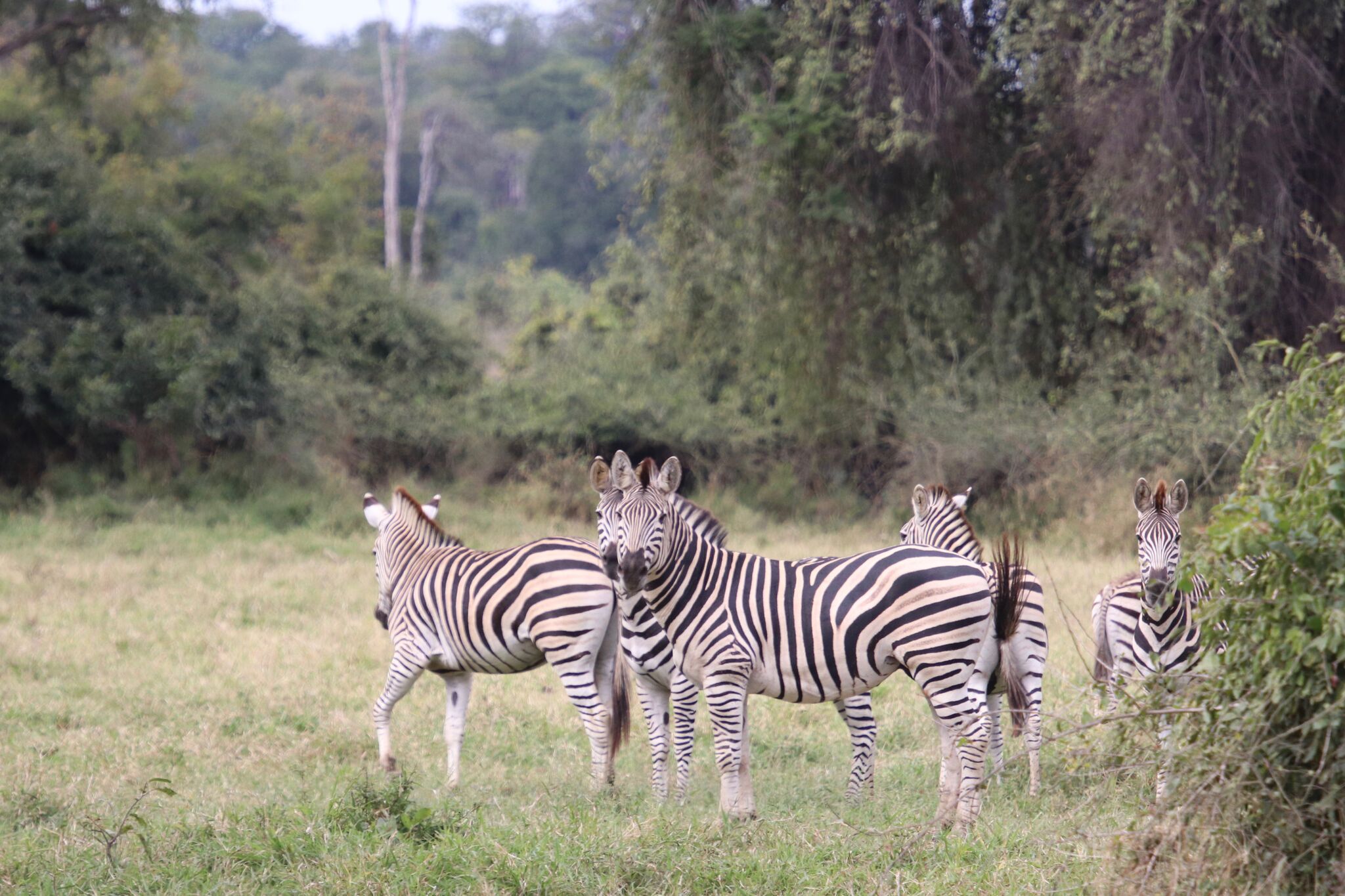
Wild zebra
Flight Facts
This vast, wild, and diverse area of the country, while offering two very different accommodation options for all level of traveler, is remote and slightly difficult to get to (it is about a seven-hour drive to the capital of Harare). Yes, you can charter flights, or, you can commit to either three or four nights and take the twice weekly flights from Johannesburg to Buffalo Range. The 1:45 minute FedAir flight takes off on Mondays and Thursdays; we were in a Beech 1900C Airliner. We didn’t realize that this flight operates out of the main terminal, since it is an international flight, and not out of the FedAir hangar 10-minutes’ drive from the main terminal. Since we were storing excess luggage, what that meant is that we had to go to the FedAir check-in at the bus terminal just outside of the main airport, get driven to the hangar to personally handover the luggage we were storing (they won’t take unaccompanied bags), and then get transferred back to the main terminal for check-in (not an issue for us, just something to keep in mind for overall timing). Guests on this flight are privately escorted through security and passport control for a seamless and time-efficient check-in, and then, as we were early, went to a restaurant for breakfast as there is no FedAir lounge at the international terminal.
Chilo Gorge
After flying low over the sugarcane plantations, we arrive at Buffalo Range and are greeted by our tracker and guide team from Chilo Gorge, Tor and Cambell. We get our USD $30 visa upon arrival, and set out in a nice transfer van for the lodge. After about 45 minutes we pass the gate to Singita Pamushana – we’ll be there later in the week. For now, we carry on another two hours before arriving at Chilo Gorge. Both lodges have their own landing strips where you can charter a flight and hop over instead of driving. In the case of Chilo Gorge, a Caravan would cut the transfer time down to 20 – 30 minutes. On the drive, we pass numerous traditional villages. As nearly 90% of Zimbabweans are unemployed, the majority live off the land, and we see the abundant, fertile soil tilled and producing on every modest homestead. Luckily they’ve received water recently as well, with the best rainfall since 2013.
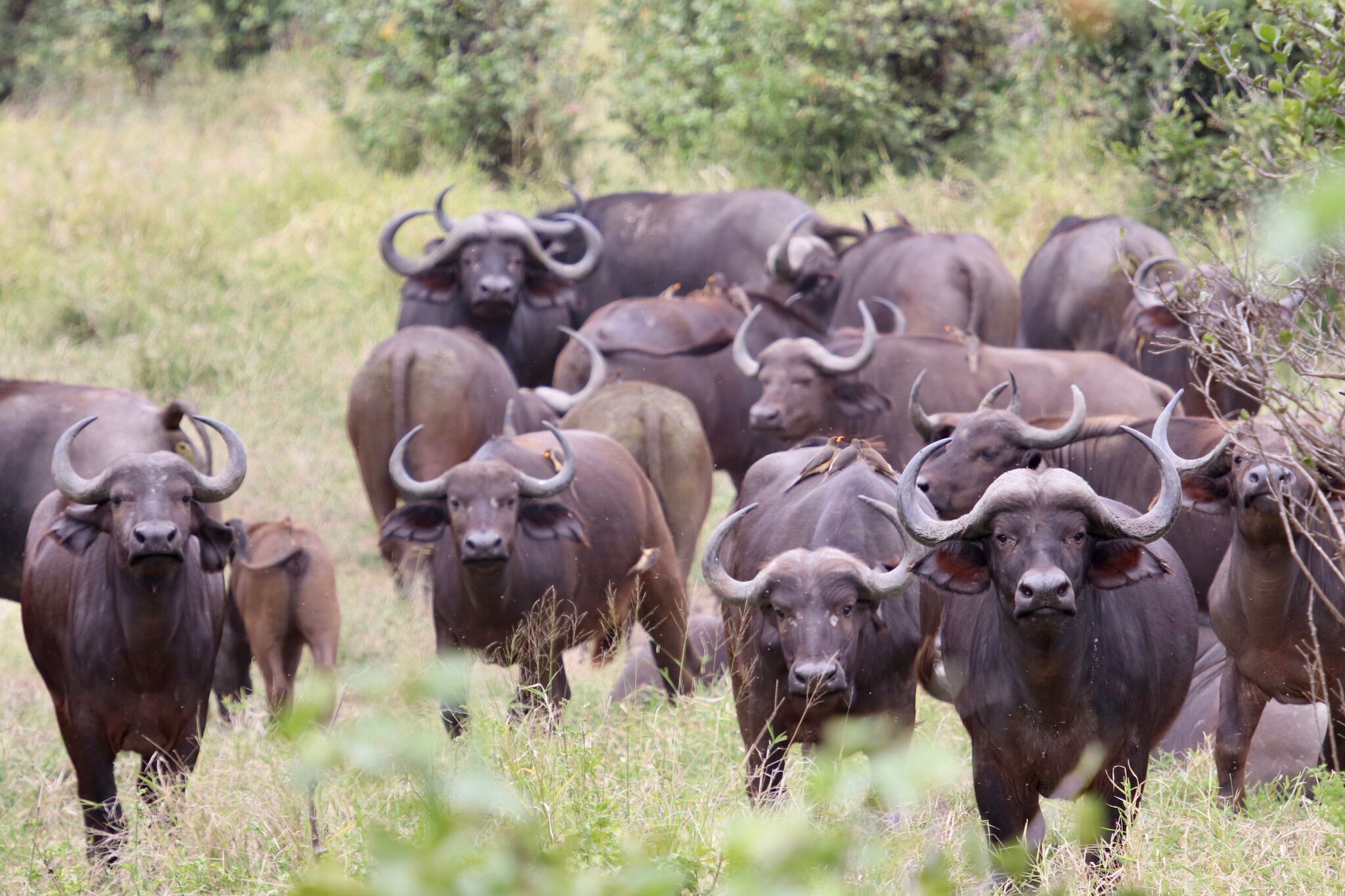
Wil buffalo
Chilo Gorge Lodge is located in a private conservation area named Jamanda on the edge of Gonarezhou National Park. The 8,000 hectare / 15 square km Jamanda Community Wildlife Conservancy is an early-stage community project being funded by the EU and offers great promise for the future. We saw the teams putting up fences in preparation for the translocation of animals. The Jamanda Conservancy, located 58 kilometers from the Chilojo Cliffs, will leave its land banking the Save River unfenced so animals can cross the water and there will also be a dam fed by the Jamanda River.
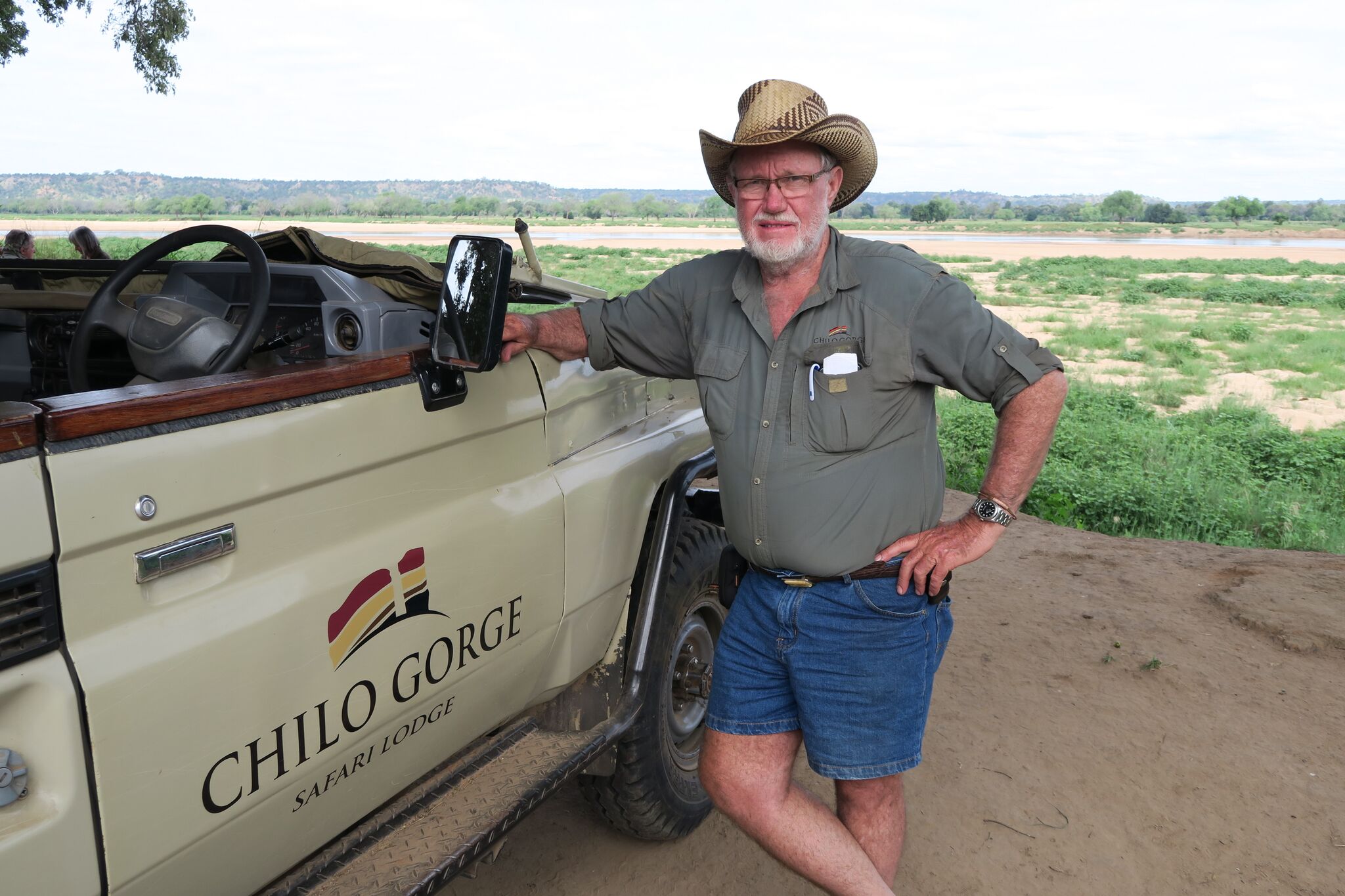
Safari ready at Chili Gorge Lodge
We are in the South East Lowveld of Zimbabwe, the lowest point in the country where the Save and Runde rivers meet. Chilo Gorge is 9km from Mozambique and Gonarezhou stretches all the way down to Limpopo in South Africa. While most of Zimbabwe is Shona, this is a Shangan area, and 90% of the staff at the lodge are from the local area. One afternoon, we explore the nearby town where Chilo Gorge works in partnership with the Mahenye Charitable Trust. Among other projects, such as a clinic, this town has a school with 20 teachers and 800 children, of which Chilo Gorge has provided for school furnishers and other supplies including a dozen computers, and fully sponsors seven orphans who now live on the school premises.
Chilo Gorge is a well-kept, unpretentious, comfortable lodge offering an incredible value for travelers wanting to have the best access to explore the untamed expanses of Gonarezhou. Of the 10 suites that make up Chilo Gorge Lodge, all suites can be set up with a twin or double configuration, all can have up to two additional beds set up for children, and two are inter-leading for families. We suggest requesting the ones with a river view as 6, 7, and 8 offer forest views and 9 has a partial river view. We also do a site inspection of the self-catering camp that Chilo Gorge has, which mostly welcomes local families from around Zimbabwe.
The first morning we commence our daily ritual of leaving the lodge around 7:30am to drive a part of the conservancy to the river and embark on little motor boat to cross over into the park. Gonarezhou is one of those places you just have to experience at some point. The National Park is half a million acres, or the size of Mauritius. While Gonarezhou is technically part of the Trans Frontier Park, it receives no allocated money because the powers that be are afraid that the Zimbabwean government will just take the funds. With that, Gonarezhou operates with the funds provided by grant programs. Four of the Big Five call this park home, as they have yet to introduce rhino; they are waiting for a time when they know they can be protected.
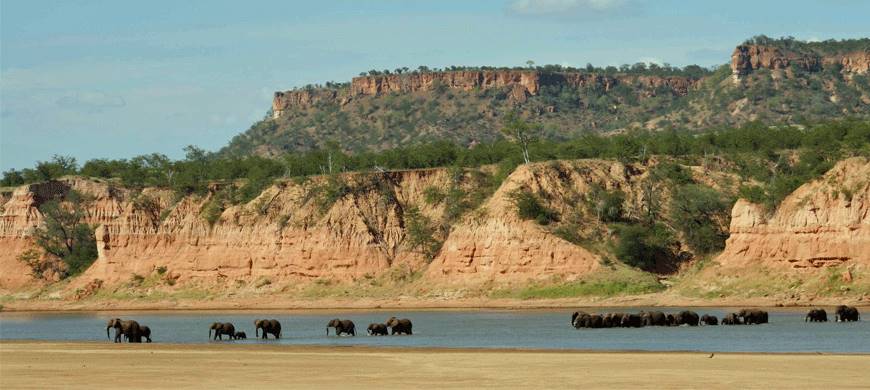
Gonarezhou National Park, photo courtesy of Sun Safaris
During the Mozambique Civil War, many elephants were poached, and there are different schools of thought on how the elephants in the park have rebounded emotionally, as today you will still come across some skittish or aggressive elephants. I asked Howard Russell, Director of Chilo Gorge, and liked his answer so much I’ll quote it: “The elephant interaction is an interesting topic, and everyone has their own view on it. Does the legacy of poaching play into their interaction/reaction – of course – albeit poaching has not be a serious issue for a good number of years now. To my mind, an arguably bigger factor is that there were only 7,000 visitors to Gonarezhou in 2016; that’s an average of 20 people or 4 vehicles a day. In a huge area. So the wildlife really does not interact with vehicles or people on a regular basis. This is further compounded by the overpopulation of elephants, making them more ready to challenge for space (or reluctant to give up on space!). I try very hard to manage expectations on wildlife viewing by telling guests that ‘the wildlife numbers and variety is very strong, but the animals are truly not habituated, and so we have to be more patient and work harder for our sightings.’ But if guests can spend a few days in the very capable hands of our guides, they will likely see good numbers and good variety.”
The guides in the park are working hard to improve the interactions elephants have with both vehicle and people – it’s all part of the larger picture of what Gonarezhou is becoming. Today you can walk anywhere in the park and over the next five to ten years the plan is to build more roads for animal viewing, and anti-poaching efforts.
The terrain is ever changing and active with countless animals. While more than 70% of the park is Mopane Tree forest, we also drive through low palm bush similar to the Lower Zambezi; across an expansive pan with teeming bird life, crocs, and hippo; through many majestic 2000-year-old Baobabs; and even past a little grove of East African Mahogany trees that some say were brought here 400 years ago when Arab traders used to move up and down the coast.
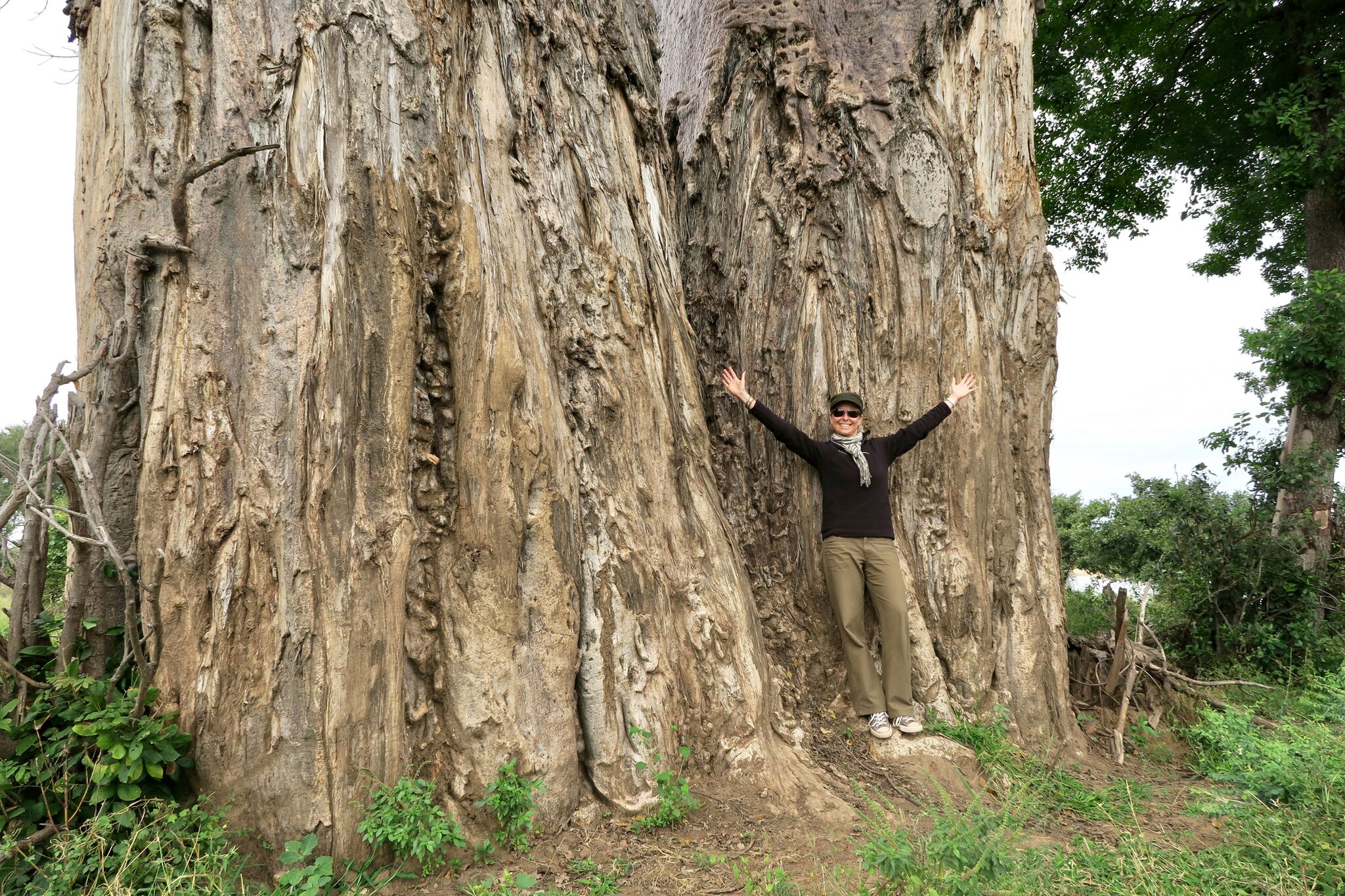
East African Mahogany tree
Around every corner we see more game: buffalo, elephant, impala and nyala, jackyl, zebra, kudu and eland, wildebeest and waterbuck, warthog … in the dry season you have better opportunity to see lion, leopard and wild dog. In October and November, it gets very hot, while June and July are very cold. On one cool and cloudy day, we take a one-hour walk from the lodge to a little picnic area overlooking a waterfall (children 12 and older are allowed on walks).
One of our favorite days was the excursion to the mighty sandstone Chilojo Cliffs, located deep in the park along the Runde River. In Shangan, Chilojo loosely translates to “tooth of an elephant”, as the formation looks like when a set of elephant teeth are laid on their side. In Shona, they are called Ghona, which is the hollow horn medicine men use for their charms, and the Shona believed that a traditional healer who used an elephant tusk for his ghona lived below the cliffs.
The Chilojo Cliffs are 200 meters high and 30 kilometers long, and have just been photographed by a National Geographic team for an upcoming feature. From the lodge it is a four-hour game drive to the cliffs, where we have lunch on the bank of the river and marvel at their beauty under the noon day sun. Thomas, Chilo Gorge’s Head Guide, who has been here since 1993 and has his Professional Hunting (PH) credentials, accompanied the National Geographic photographer on the expedition as they camped on the banks of the river in order to get the best shots at day break and sunset. Camping in the park is possible, and Chilo Gorge even offers an exceptional excursion along the Ivory Trail, where guests hike and camp from the far west of the park through to their last night at the lodge, with Clive Stockil as their guide. Clive is the Founder of the Campfire Initiative in Zimbabwe, one of the directors of Chilo Gorge, and directly involved in the restoration of Gonarezhou. He is also one of Zimbabwe’s most renowned guides, and we meet up with him and Garth Thompson on their last night of one of these excursions.
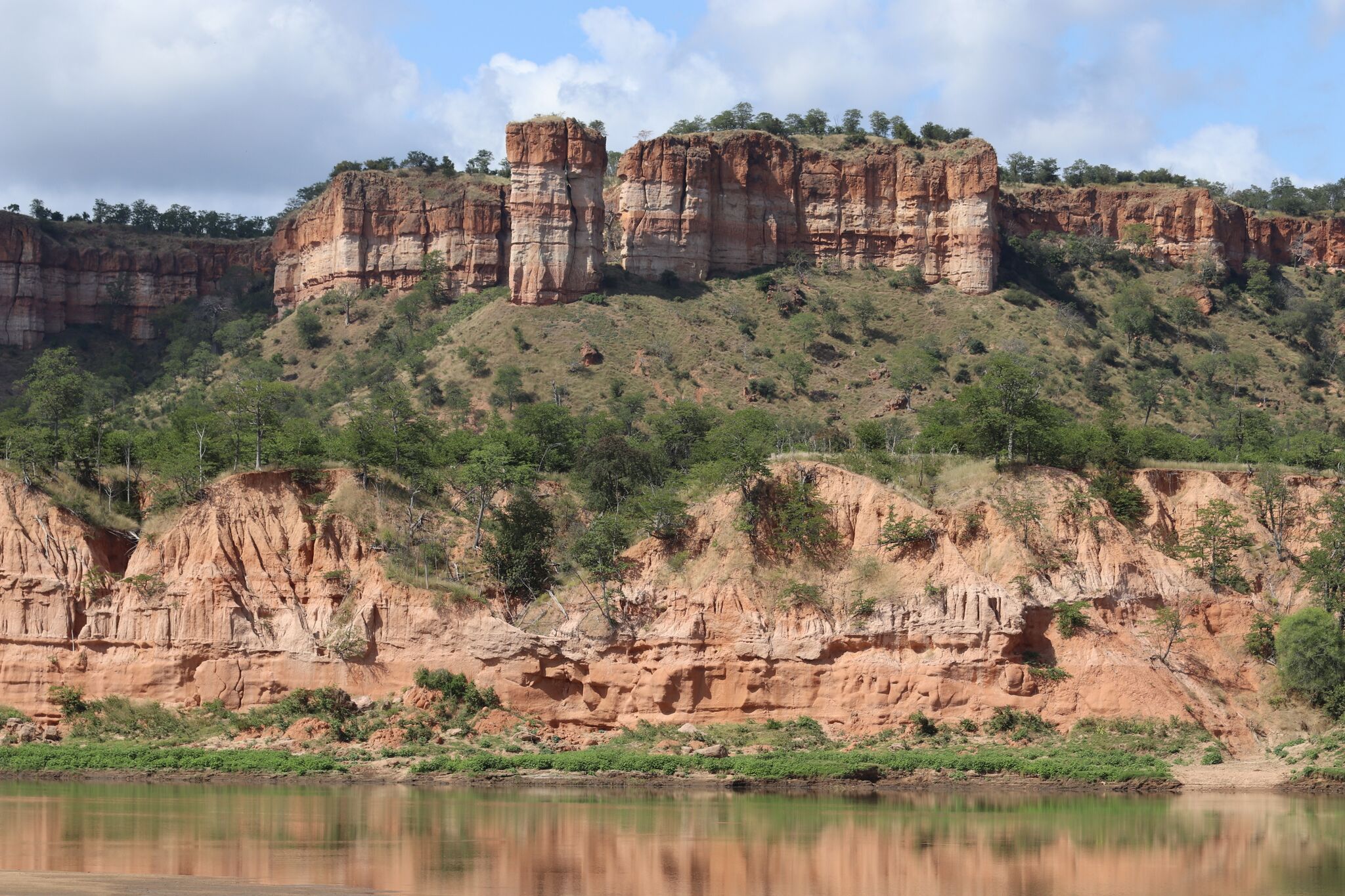
The Chilojo Cliffs
On one drive we spot the mountain top Kundani, or Place of Victory, which is where the Shangan overtook the invading Venda King who then retreated back to South Africa. There is a deep and vast ancestral history throughout all of Africa, and parts of it come to life here through stories and sightings.
There is also new life here. In the past five years, three new bird species have been identified in this region, which were never present before. Unfortunately, Chinese logging in Mozambique is causing habitat loss and many animals are migrating into Zimbabwe. Of the 600 bird species in Zimbabwe, 450+ are found in Gonarezhou, many of which are endemic to the area.
Singita Pamushana
Singita’s Pamushana lodge is located within Malilangwe, which is a 130,000-acre / 52,000-hectare private concession with three lodges in total, though only one is used for guests and the others for conservation education for school groups and researcher housing. There is about 140km of fence surrounding Malilangwe, in part to help protect the resident rhino, of which there are more than 200, both black and white, equaling the largest concentration in Africa. Because the land is private, guides have more liberty to stay out later into the night. For guests who stay longer (either 4 or 7 nights) they’ll often still go into Gonarezhou to explore there as well (from Pamushana it takes about 3.5 hours to drive to the Chilojo Cliffs so that going there becomes a full day outing as well). Guests can also visit the Great Zimbabwe ruins, which was once used as a trading post and where the country gets its name from – Great Zimbabwe is the most significant structure built in sub-Saharan Africa and is a 2.5-hour drive from Pamushana as well.
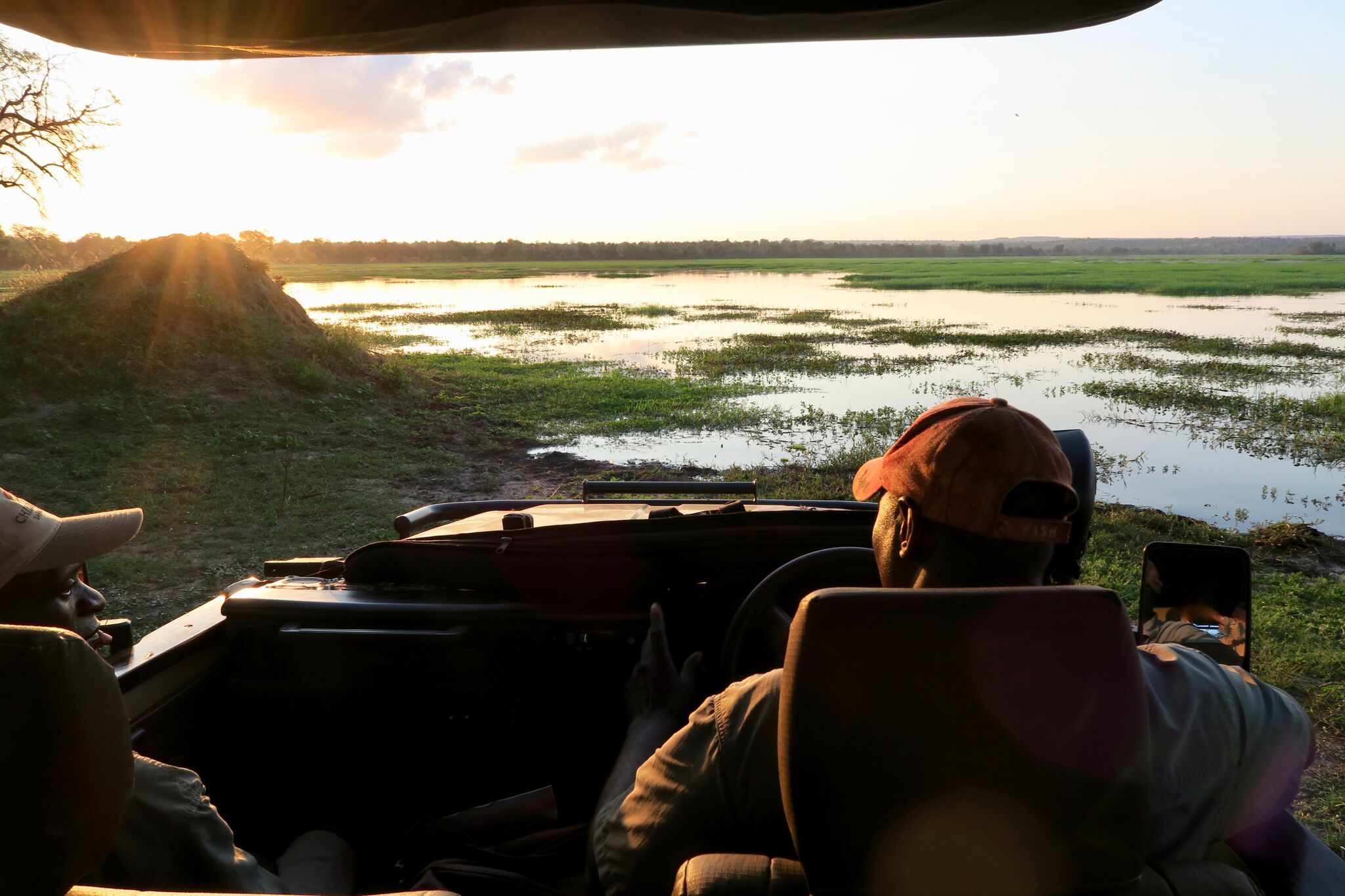
Sunset safari views
The design of Pamushana echoes the design of Great Zimbabwe. You can see elements of the architecture in the 8 nearly identical, slightly outlandish, definitely decadent, rooms. The five-bedroom villa carries the same bursts of color, attention to detail, and enviable art, and feels just slightly more modern. Pamushana actually means “A Place In The Sunshine” and this becomes truly evident in the mornings when we wake up to sunrise glistening on the dam waters in front of the lodge.
Malilangwe, which means “Call of the Leopard” is a wholly Zimbabwean Conservation Trust. It offers Big Five animal viewing along with unique cultural experiences and other activities. At Pamushana guests enjoy sundowner boat cruises on the dam, the same waters on which they can also fish for Tiger and Bream. We do the full morning excursion to Kambako Village, which means “Way of the Elephant”, and is a living museum created in 2011 to preserve the lineage of the Shangaan people and keep their cultural experience alive. Johann and I take part in fire making, water divining, iron forging, bow and arrow making/target practice, salt making and cooking, basketry and weaving, and more … and can I just say, it’s a good thing we have modern machinery in our home because we would be in a world of hurt if we had to do these things to survive!
The other agents we share a vehicle with decide to do the community tour to visit the K-7 Grade School and participate in the daily offering of nutritional meals to the children. The Malilangwe Trust sponsors the meals for 19,000 children in the community and school; there is also a clinic that was built and sponsored by the Malilangwe Trust, which offers classes in health and hygiene by teachers who live on the premises.

Sunset over Zimbabwe
Tyme, who has been with Singita nearly a decade, is our guide. During our time with him and David, our tracker, we visit several of the more than 80 sites with ancient Bushman paintings, witness a rhino notching, cruise the waters of the 250-acre dam in front of the lodge, and more. Tyme and David brought Malilangwe to life instantly. With more than 35 types of habitat within Malilangwe, the land is home to a diverse array of fauna, and we saw most of the 26 wild dog (including some that were antagonizing hyena), lots of the 40 lions (among four prides), a rambunctious ellie in must taking down the Mopane, ample antelope (klipspringer, waterbuck, bushbuck, kudu), and plains game just after birthing time with nursing zebra, impish impala, and gentile giraffe.
All of these animals, and others, along with activities like hunting and rain-making ceremonies, are immortalized on 200-meter’s worth of bushman paintings along the hills around Malilangwe. The paintings, which are around 1000 year’s old, are still vibrant today, having been made with a blend of ocher from the iron oxide in the rocks with blood or tree dies. The San Bushman originated from motopos in Zimbabwe and at one time one painting of a person was used as a symbol on the Zimbabwean postage stamp.
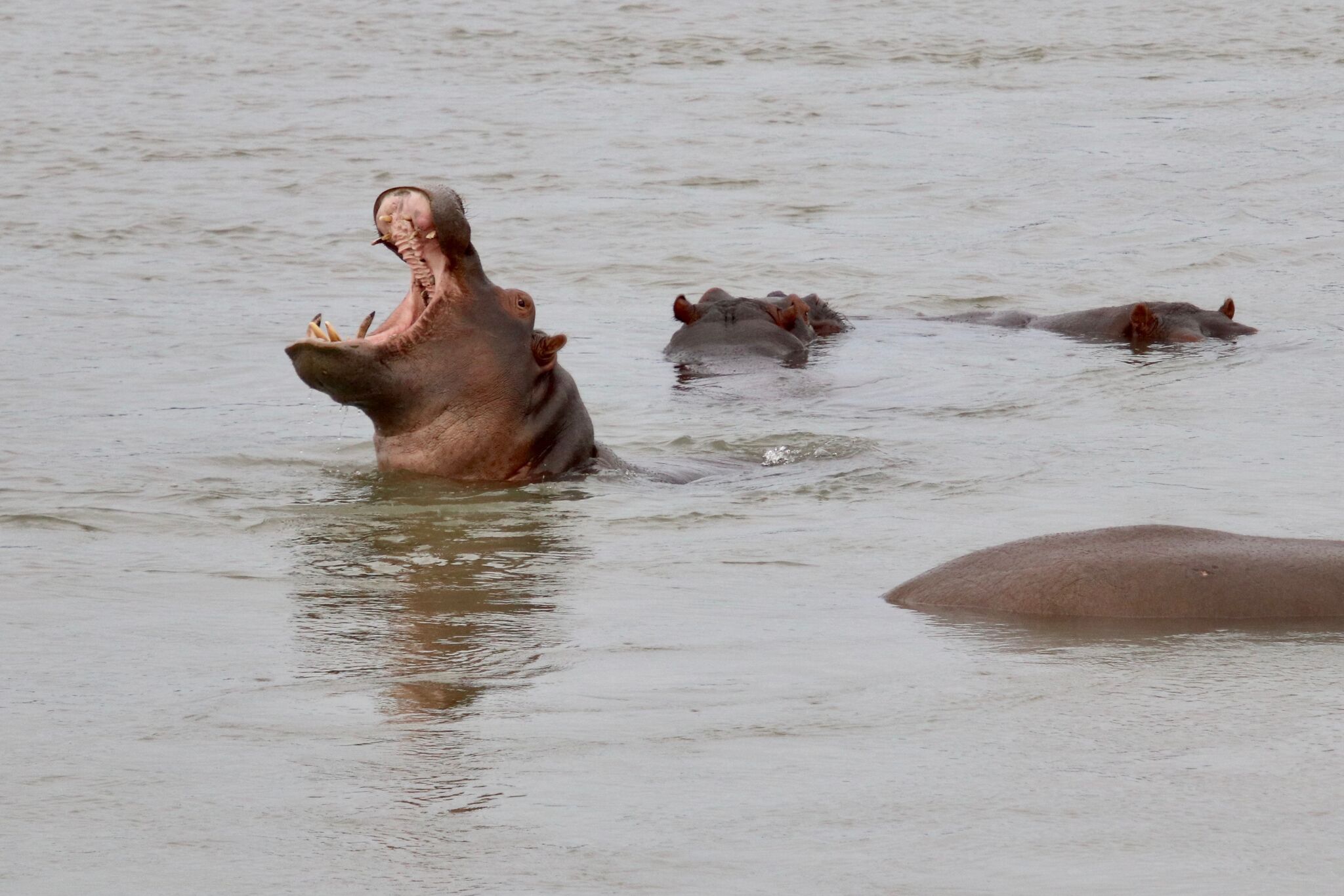
Hippos bathing and expressing themselves
One of the most moving experiences we have is participating in the last rhino notching of the season; the next opportunity would be a few months later. There is a 21-month-old black rhino that needs to be notched before turning two years, the age at which they generally leave their mother. We learn that notching doesn’t usually take place on a rhino younger than 6 or 7 months, yet needs to be done while still with the mom so that they can correctly identify the blood line and genealogy. Colin Wenham, Head of Wildlife and Conservation for the Malilangwe Trust, and Sara Clegg, a biologist who is married to Dr. Bruce Clegg, the Malilangwe Trust’s resident ecologist are there with the team of vets, assistants, and the helicopter. Notching is one way to help with conservation efforts, and the Malilangwe Trust employs more than 80 anti-poachers on the security team.
As neither of us has participated in or witnessed a rhino notching before, there is an air of excitement about being so close to conservation-in-action with this precious rhino, and yet, I am also deeply saddened that it has to undergo any level of unnatural, invasive handling at the hands of humans, because of humans. Many travelers have an image in their mind of what it would be like to witness a kill, an intervention, a notching, and yet, until you are actually there in person, it is hard to understand how you will react. There is a full spectrum of awareness and emotion going on at the same time, and similarly to the last animal intervention I was a part of in Kenya, I feel the need for reverent silence afterward.
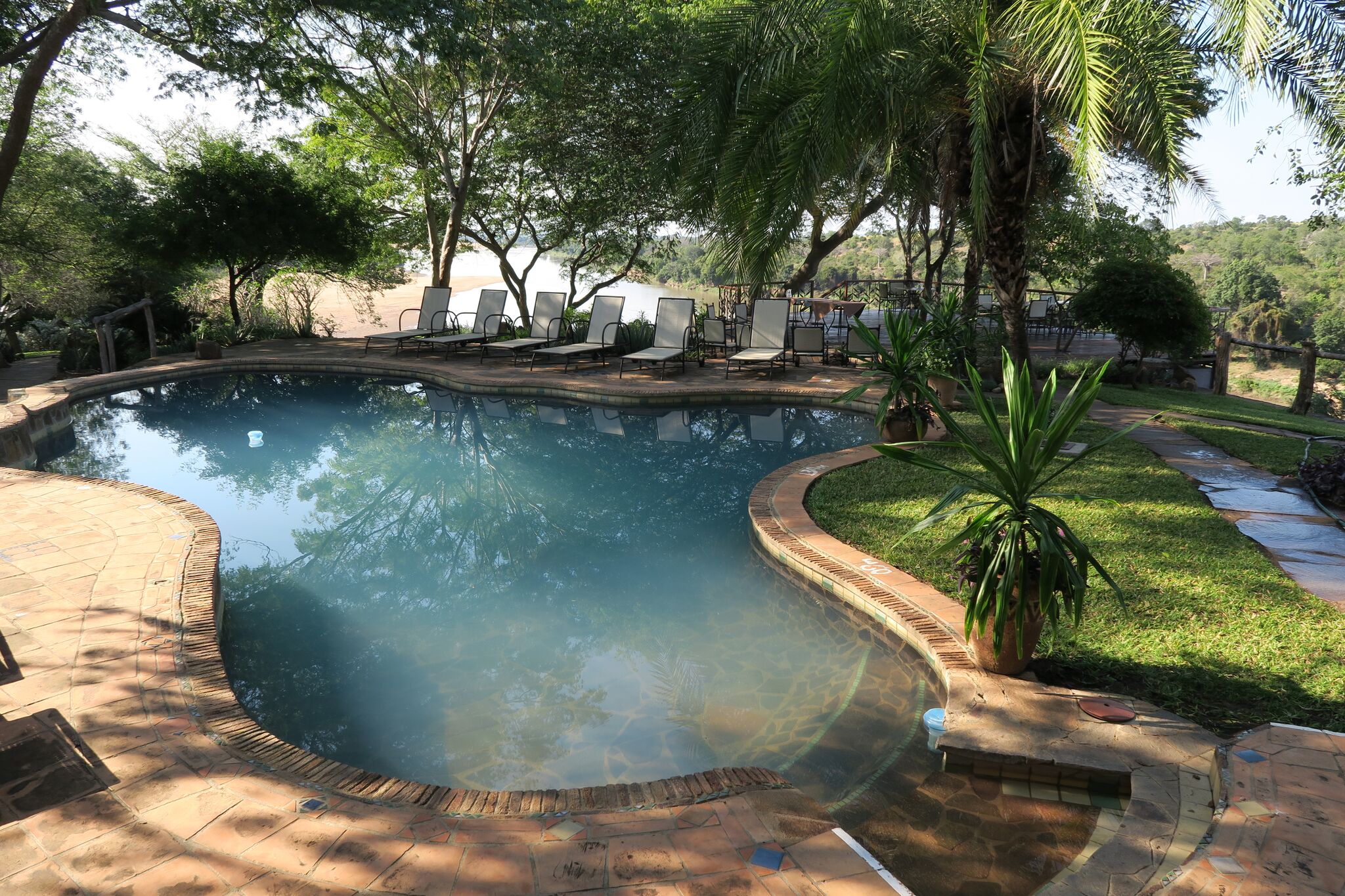
A quiet moment at the lodge
Reverence seems to carry though much of our safari. Taking calm, peacefulness to another level, there are many times driving out or back when we crest the top of a sandstone kopje and Tyme turns the engine off so we coast down the road in silence … especially lovely for listening to the bird calls as the sun rises or for reflection on the rhino notching on our last night.
Back at the lodge, we realize again and again how the relentless refinement of a Singita sojourn comes to life at Pamushana, well beyond the luxury linens and fast Wifi. Sifundo, who is the man who cares for us during our stay, is the consummate professional. Sifundo means “A Lesson”, and he tells us his family is from Matabele land. During our three days at Pamushana, he is engaging, passionate, humble, and transformative. He is the reason I that we experience what many people realize while on safari: we all come to Africa for the animals, and we leave longing for the people.
